The global economy is facing rifts comparable to the pressures that resulted in “economic nationalism”, a collapse in global trade and the Great Depression of the 1920s, the president of the European Central Bank has warned.
“We have faced the worst pandemic since the 1920s, the worst conflict in Europe since the 1940s and the worst energy shock since the 1970s,” said Christine Lagarde on Friday, adding that these disruptions combined with factors such as supply chain problems had permanently changed global economic activity.
In a speech at the IMF in Washington two days after the Federal Reserve cut interest rates by 50 basis points, pushing US equity markets to record highs, the ECB president argued that several parallels “between the “two twenties — the 1920s and 2020s — stand out”, pointing to “setbacks in global trade integration” and technological advances in both eras.
While monetary policy in the 1920s made matters worse as adherence to the gold standard pushed leading economies into deflation and banking crises, “we are in a better position today to address these structural changes than our predecessors were”, stressed Lagarde.
A century ago, she said, central bankers learnt the hard way that pegging the currency to gold and fixed exchange rates was “not robust in times of profound structural change” as it pushed the world into deflation, fuelling “economic malaise” and contributing to a “cycle of economic nationalism”.
Today, central bankers’ tools for preserving price stability “have proved effective”, she said. Lagarde pointed to the quick fall in inflation once central banks started to raise rates in 2022. Consumer prices had shot up following a surge in post-pandemic demand, global supply chain disruptions and big rises in energy prices after Russia’s full-scale invasion of Ukraine.
She described the episode as an “extreme stress test” for monetary policy.
Central bankers have been able to ease monetary policy in recent months as price pressures abated. Annual inflation in the Eurozone peaked at 10.6 per cent in October 2022 but hit a three-year low of 2.2 per cent in August.
Lagarde said it was “remarkable” that central banks managed to get inflation under control within less than two years while avoiding a rise in joblessness. “It is rare to avoid a major deterioration in employment when central banks raise rates in response to high energy prices. But employment has risen by 2.8mn people in the euro area since the end of 2022,” she said.
However, the ECB president warned against complacency, saying that issues including possible setbacks to globalisation, a partial disintegration of global supply chains, the market power of tech giants such as Google and the “rapid development of artificial intelligence” could all test central bankers.
Uncertainty would “remain high” for monetary policymakers, Lagarde said, adding: “We need to manage it better.”
The ECB will investigate these issues in detail in its looming strategy review, she said. While its 2 per cent medium-term inflation target would not be scrutinised, “we will consider what we can learn from our past experience with too-low and too-high inflation”, she said.
The ECB would also analyse its assessment and disclosure of risks. For example, its baseline inflation scenario could be “balanced . . . with real-time information”, and the central bank could also disclose alternative scenarios.
































































































































You must be logged in to post a comment Login